SOS is the featured cover story of the 2018 May/June Central New York MD News Magazine
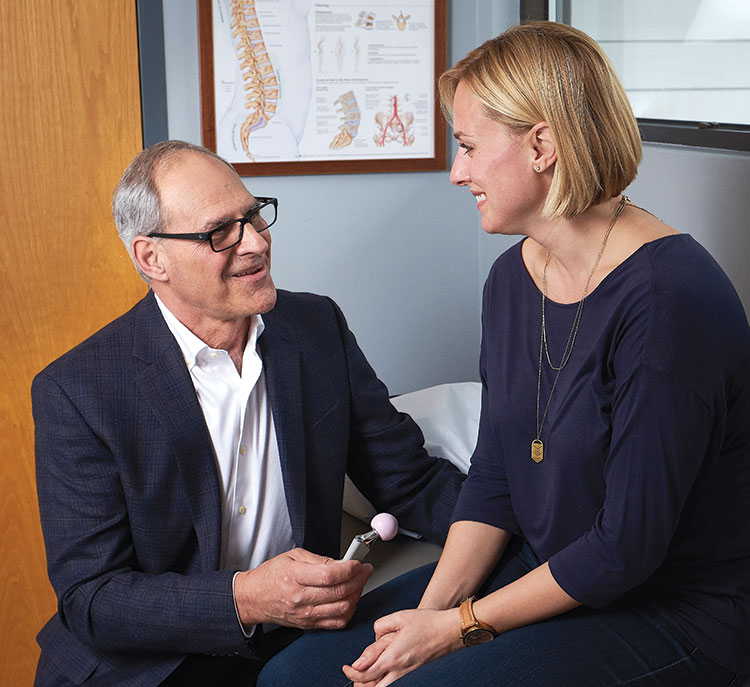
Stephen P. Bogosian, MD, confers with a patient.
With comprehensive orthopedic offerings and physicians whose expertise spans the spectrum of orthopedic subspecialties, Syracuse Orthopedic Specialists (SOS) provides treatment for the most complex bone and joint conditions. Yet the practice is also community-centric — patients can access high-quality orthopedic care at seven strategically located offices across Onondaga County.
As the field of orthopedics has evolved, so has SOS. Since the practice was founded in 1999, SOS has been committed to caring for patients across Central New York and beyond. With the addition of newly trained physicians in sports medicine, foot and ankle surgery, and more, SOS continues to expand the list of complex procedures its providers offer.
The Evolution of Orthopedics
Today, when a patient is referred for an initial consultation at SOS, he or she will likely meet with a physician who focuses specifically on his or her particular issue. This reflects a trend in the greater field of orthopedics, in which the majority of new physicians progressing through medical training specialize more deeply, leading to more specialists and fewer general orthopedic physicians and surgeons.
At SOS, patients benefit from a collaborative environment in which more experienced orthopedists share valuable insight with newer, specialized orthopedists. In turn, specialized orthopedists introduce new technologies and techniques to the team. Brett Greenky, MD, MS, President of SOS, admires the cooperative spirit of all the practice’s providers, who work together to grow their skill sets and improve patient care.
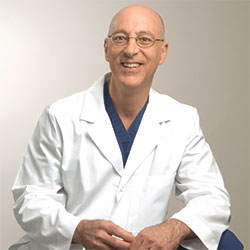
Brett Greenky, MD, MS, President of SOS
“When I did my fellowship from 1989–1990, less than half of physicians added that year or two of fellowship training after the traditional five-year orthopedic residency,” Dr. Greenky says. “Today, more than 95 percent are fellowship-trained. The field has evolved dramatically. The task of keeping up with orthopedic knowledge and becoming an expert in the entire field has become more arduous, so physicians focus on smaller segments of the continuum. Initially, fellowships existed for hand and total joint surgery, and now the field has added fellowships in other subspecialties, including spine surgery, sports medicine, foot and ankle surgery, and trauma.”
This specialization highlights and refines skill, Dr. Greenky adds, drawing on the metaphor of music to explain his thoughts on the shift away from a general orthopedics-based practice.
“I think of orthopedic practice as an orchestra,” he says. “You can’t be a master flute player and also a master percussionist. Generally, you have to concentrate on one instrument. When we all play together, it’s a wonderful sound, and there aren’t a lot of one-man bands around.”
This symphonic harmony is a trend that Frederick Lemley, MD, orthopedic foot and ankle surgeon at SOS, believes will continue.
“Specialization is ultimately good for patients and improves surgical quality,” Dr. Lemley says. “The more you do something, the better you get at it.”
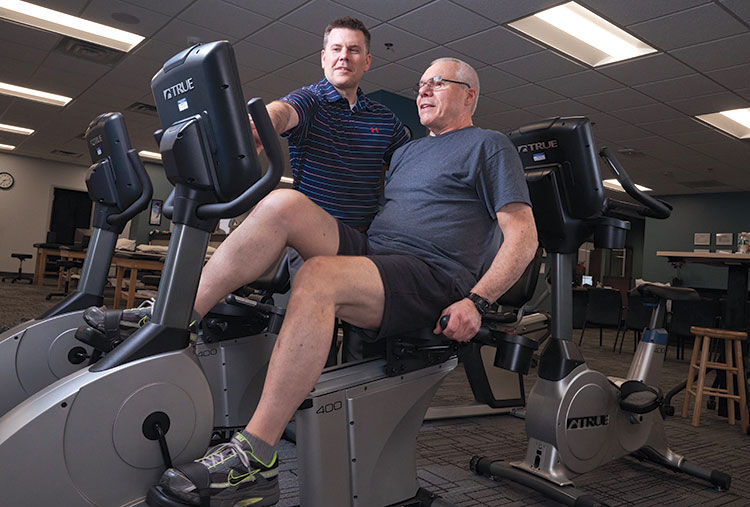
Stacy Griffith, PT, works with a patient on a stationary bike.
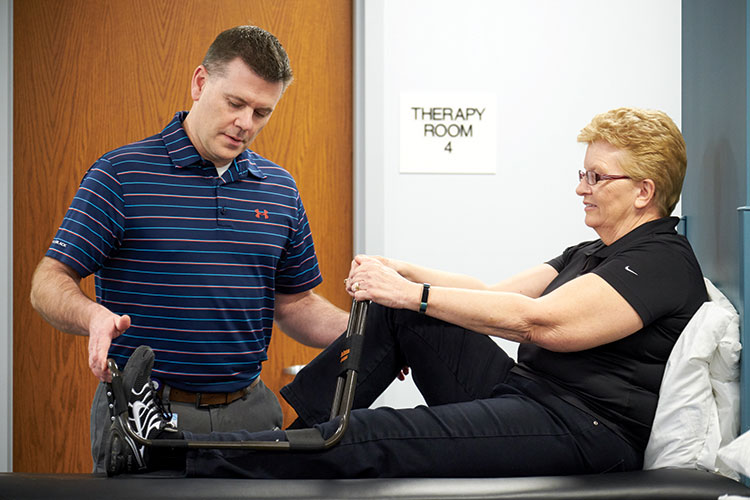
Griffith oversees a patient’s progress.
Todd Battaglia, MD, MS, Director of the Sports Medicine Department at SOS and head team orthopedist for Syracuse University Football, began his career in the early phases of this dramatic shift, and he foresees even more precise specialization as the discipline evolves.
“I completed my training 12 years ago with two fellowships, one in research and science and the other in sports medicine and arthroscopic shoulder and knee surgery,” Dr. Battaglia says. “Today, the greater part of my practice focuses on sports injuries and reconstruction of complex problems of the shoulder and knee. We can all manage the care of patients with basic fractures, but 90 percent of my practice, for instance, falls under the heading of sports medicine and arthroscopic surgery.
“I suspect, as our knowledge base and the complexity of the procedures we can provide increase — especially when you factor in technological advances — the industry will become even more subspecialized,” he continues. “We recently started offering a subspecialty board for sports medicine, for instance. I wouldn’t be surprised to soon see a specific certification for spine surgery or joint replacement. Education and best-practice-based specialization are something we embrace here at SOS.”
Orthopedics without Walls
SOS’s widespread clinic footprint has led the practice to describe itself as “centers without walls.” For added accessibility, SOS offers multiple specialties, alongside general orthopedics, at many locations, uniting the expertise of specialty care with conveniently located offices. Patients from DeWitt to Clay can find offices in their neighborhoods with experts in:
- Foot and ankle
- Hand and wrist
- Joint replacement
- Orthopedic and sports therapy
- Neck and spine
- Sports medicine
“We want to fulfill all patients’ orthopedic needs under one roof without them having to visit different offices,” says Brad Raphael, MD, a sports medicine specialist at SOS who is also a team orthopedist for Syracuse University, referring to the new clinic in Liverpool as an example. “It’s more efficient, saves time and allows for a better, quicker experience for the patient, while also improving care and outcomes.”
For patients, that means a more seamless experience and less frustration, because they start care with the appropriate specialist and have access to additional support as needed. From initial evaluation to diagnostic testing, physical therapy and surgery, each department oversees the overall progression of its own patients. Some offer special services, such as the Durable Medical Equipment (DME) Department for splints and braces, or the SOS Shop, a retail store with physician-recommended products to aid in patient recovery and enhancing overall health.
“We try to achieve as much direct continuity from one aspect of the group to the next as we can,” Dr. Battaglia says. “It simplifies life for our patients.”
Research and Quality Control
In addition to its community model, SOS is devoted to improving quality and efficiency across every discipline and every practice. Many SOS physicians also contribute to scientific understanding of bone and joint issues through advanced research. The SOS Joint Replacement Council, Spine Council and Research Council were developed to further these aims and maintain high standards of research and patient care across their respective programs.
In each council, physicians meet for case reviews to discuss ways to improve outcomes for patients. Data is collected into registries so outcomes can be tracked and scrutinized.
“The Joint Replacement Council meets monthly,” Dr. Greenky says. “We review literature, update our protocols based on the most current scientific data and review individual cases to discuss the most appropriate treatments. Patients are ultimately managed by the treating physician, but as a team, we discuss cases that warrant a closer look or present specific challenges.”
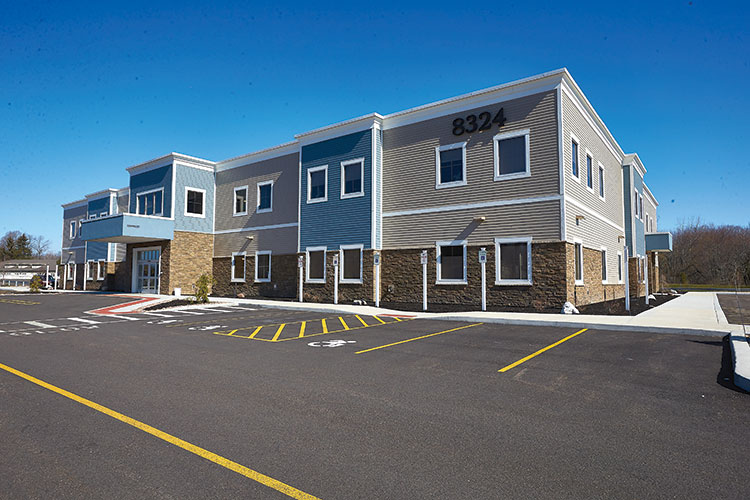
Exterior of the new office at 8324 Oswego Rd in Liverpool.
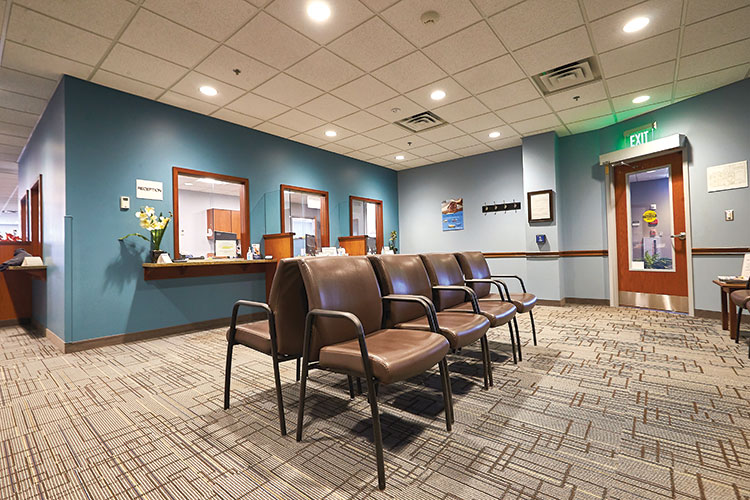
Interior of the new office at 8324 Oswego Rd in Liverpool.
The Research Council collects data for the national Joint Registry, where it is pooled and analyzed to identify factors such as superior surgical approaches or problematic implant performances. SOS also maintains its own Joint Registry, and perusing it reveals the practice’s outstanding performance metrics, including blood transfusion rates of less than 1 percent and intraoperative complications of 2.35 percent, well below the national average.
“We have about 7,000 joint replacement operations in our registry,” Dr. Greenky says. “That’s crucial to our research and to upgrading the national database. We track patient data from before surgery and at intervals during recovery, culminating in follow-ups every decade, to examine survivorship of implants.”
Other research projects include university-sponsored studies. SOS surgeons presented one study examining the use of UV light during joint replacement to reduce the risk of perioperative infection at the American Academy of Orthopaedic Surgeons’ conference in March 2018. Data from 4,000 cases were used in the research, Dr. Greenky says.
A Reputation for Success
The SOS team works diligently to make sure the practice earns its reputation for excellence, reliability and openness.
“We’re the largest orthopedic service provider in Central New York,” Dr. Greenky says. “I’d like our referrers to know we put time and effort into making sure we do a great job for every patient. We stay on the cutting edge of treatments, we are aiming to have experts in every subspecialty and currently have specialists in the majority of subspecialties. Most importantly, we make sure we have their patients’ backs, figuratively and literally.”
“We remain committed to providing the latest in orthopedic care here in Central New York,” Dr. Battaglia adds. “We hire orthopedists with the latest training who expand access to new techniques and technologies for both their own patients and patients of their colleagues, providing a level of service and expertise that rivals anywhere in the country.”
Case Study: Foot and Ankle Care
Frederick Lemley, MD, orthopedic foot and ankle surgeon at Syracuse Orthopedic Specialists (SOS), originally planned to become a general orthopedist and at the last minute decided to complete a fellowship in foot and ankle surgery, exemplifying orthopedic medicine’s trend from general to specialized. Even within his specialty, Dr. Lemley finds diversity. His cases range from bunions to full ankle replacement, he says, and he enjoys days filled with varied and unique cases.
SOS supports his work with a wide range of foot and ankle diagnostic and therapeutic services, he says, which integrate seamlessly into SOS’s robust physical therapy program.
“We have top-quality digital X-ray imaging, which we rely on heavily in the foot and ankle field,” Dr. Lemley says. “We also have MRI available. When it comes to treatment, we often use braces, shoes and orthotics to help patients. SOS employs a dedicated pedorthist who specializes in making braces, custom footwear and orthotics.”
Rather than wait for an order or search for a product, many patients find appropriate over-the-counter items, such as socks and orthopedic shoe gear, at SOS’s retail store, The SOS Shop, which is located within the Foot and Ankle Center. PT is also offered in SOS’s foot and ankle center.
“We take our patients right upstairs to PT,” Dr. Lemley says. “They can learn to transfer and use a scooter right here in the building. Foot and ankle recovery is always tough; it impacts patients’ lives and their jobs. We do our best to make things easy for patients.”
Coming Soon!
Syracuse Orthopedic Specialists (SOS) is relocating and expanding the Specialists One Day Surgery Center to Cicero the first quarter of 2019. Total joint and spine procedures will be performed in the new facility, which will be three times the size of SOS’s current surgery center and feature eight operating suites. Co-location of joint and spine services and physicians will allow for greater collaboration among medical team members and facilitate easier scheduling for patients.
